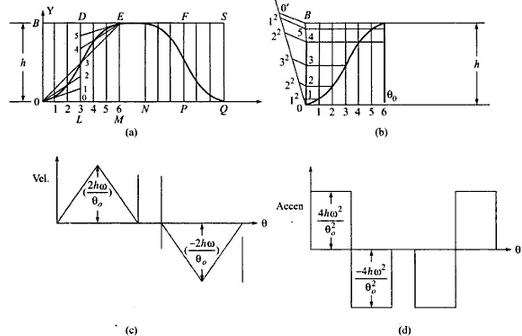Parabolic Motion or Motion with Constant Acceleration and Retardation:
The technique of constructing displacement diagram is as:
(a) Divide displacement interval into acceleration & deceleration part. If and retardation and acceleration are equivalent than this shall be θo /2 or θr/2 for acceleration and θo/2 or θr/2 for declaration. If acceleration is twice the retardation, then, it shall be θo/3 or θr/3 for acceleration as well as 2θ/3 or 2θr/3 for retardation. Likewise, the lift is divided. Divide acceleration & retardation parts into equivalent parts say n = 4.
(b) Spilt lift portions in n2 or say 16 parts.
(c) Project 1 to primary ordinate, 22 as 4 to second ordinate, 32 as 9 to third ordinate, 42 as 16 to fourth ordinate to get point on displacement diagram.
(d) Repeat the process mentioned in (c) for other part to obtain remaining part of displacement diagram.
The diagram is illustrated in Figures (a) and (b).

As motion is parabolic
Let y = C θ2
here C is constant of proportionality.
Let y = L/2 when θ= θo/2 (for equivalent acceleration and retardation)

Putting for C

Thus,

and acceleration

Maximum velocity

Maximum acceleration

For return stroke the following expression present

The, velocity, displacement and acceleration diagrams are shown in Figure.